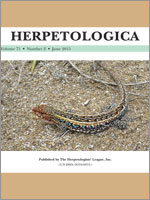Populations of unisexual Ambystoma salamanders typically consist of ploidy-variable individuals (diploid through pentaploid) that differ in their proportional representation within the populations. These salamanders reproduce using a method that has been termed kleptogenesis: stealing genetic material from males of compatible bisexual Ambystoma species (e.g., Jefferson Salamanders [A. jeffersonianum] and Blue-spotted Salamanders [A. laterale]). Kleptogenesis can result in ploidy-variable embryos within an egg mass because the unisexual female might or might not incorporate the male genome. Little is known about the survivorship of individuals having different ploidy levels. Triploid individuals are most abundant, indicating that higher ploidy individuals (tetraploids and pentaploids) are either produced more rarely, or suffer higher mortality than triploids. We assessed the frequency of ploidy levels (determined by microsatellite analysis) across four life-history stages over 2 yr: adults, early larvae, late larvae, and metamorphosed juveniles. We found that warmer breeding-season temperatures were correlated with an increased frequency of high-ploidy individuals being produced. In addition, there was a gradual decline in tetraploids across all stages as the larvae developed into adults. Breeding season temperature and selection against certain ploidy levels both appear to be important drivers of unisexual salamander population composition at our study site.
How to translate text using browser tools
1 June 2015
Survivorship of Ploidy-variable Unisexual Ambystoma Salamanders Across Developmental Stages
Christina Teltser,
Katherine R. Greenwald
ACCESS THE FULL ARTICLE

Herpetologica
Vol. 71 • No. 2
June 2015
Vol. 71 • No. 2
June 2015
Caudata
Kleptogenesis
microsatellites
survival
tetraploid
triploid




